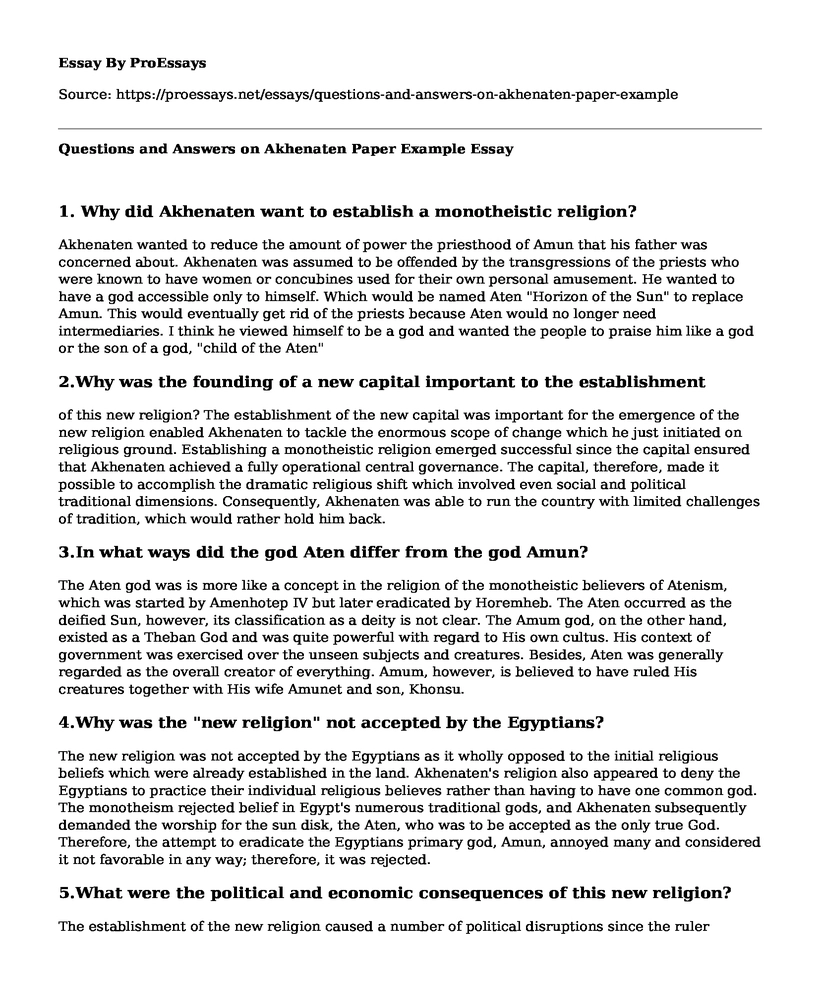1. Why did Akhenaten want to establish a monotheistic religion?
Akhenaten wanted to reduce the amount of power the priesthood of Amun that his father was concerned about. Akhenaten was assumed to be offended by the transgressions of the priests who were known to have women or concubines used for their own personal amusement. He wanted to have a god accessible only to himself. Which would be named Aten "Horizon of the Sun" to replace Amun. This would eventually get rid of the priests because Aten would no longer need intermediaries. I think he viewed himself to be a god and wanted the people to praise him like a god or the son of a god, "child of the Aten"
2.Why was the founding of a new capital important to the establishment
of this new religion? The establishment of the new capital was important for the emergence of the new religion enabled Akhenaten to tackle the enormous scope of change which he just initiated on religious ground. Establishing a monotheistic religion emerged successful since the capital ensured that Akhenaten achieved a fully operational central governance. The capital, therefore, made it possible to accomplish the dramatic religious shift which involved even social and political traditional dimensions. Consequently, Akhenaten was able to run the country with limited challenges of tradition, which would rather hold him back.
3.In what ways did the god Aten differ from the god Amun?
The Aten god was is more like a concept in the religion of the monotheistic believers of Atenism, which was started by Amenhotep IV but later eradicated by Horemheb. The Aten occurred as the deified Sun, however, its classification as a deity is not clear. The Amum god, on the other hand, existed as a Theban God and was quite powerful with regard to His own cultus. His context of government was exercised over the unseen subjects and creatures. Besides, Aten was generally regarded as the overall creator of everything. Amum, however, is believed to have ruled His creatures together with His wife Amunet and son, Khonsu.
4.Why was the "new religion" not accepted by the Egyptians?
The new religion was not accepted by the Egyptians as it wholly opposed to the initial religious beliefs which were already established in the land. Akhenaten's religion also appeared to deny the Egyptians to practice their individual religious believes rather than having to have one common god. The monotheism rejected belief in Egypt's numerous traditional gods, and Akhenaten subsequently demanded the worship for the sun disk, the Aten, who was to be accepted as the only true God. Therefore, the attempt to eradicate the Egyptians primary god, Amun, annoyed many and considered it not favorable in any way; therefore, it was rejected.
5.What were the political and economic consequences of this new religion?
The establishment of the new religion caused a number of political disruptions since the ruler Akhenaten forcefully implemented it as a common requirement for all the Egyptians. He did this without allowing the incorporation of the inputs of other political leaders and the political provisions which were already in place. Besides, negative economic consequences were experienced as it meant significant use of resources to restore the original status of the temple art. However, a positive economic significant also resulted when art created job opportunities for many.
6. How did the "new religion" impact artistic development during the reign of Akhenaten?
The new religion had unique aspects which were o be represented in new forms of images. For instance, the God who was to be worshiped by the monotheist believers was to be shown in His own image. There were objects, drawing and painted arts. The reign of Akhenaten, therefore, promoted artistic development.
7.What were the causes of Egypt's decline in the latter days of Akhenaten's reign?
Egypt declined in the latter days of Akhenaten since he tried to set up a number of reforms which however failed to be implemented successfully. Moreover, their were significant political disturbances while Akhenaten faced serious oppositions from almost all parts of the country. The country was less stable in all sectors, therefore, was most likely to face decline.
Define:
1.Impieties
Impieties refer to different practices which showed lack of reverence to a sacred being. This occurred many times during the Egyptian dynasties, where various people emerged to rejects their gods.
2.Delineate
This is to provide a definitive portrayal of someone or something. In Egypt thongs, people and sacred beings were delineated by refereeing to them with unique identifying characters.
3.Cartouche
A cartouche was an oval shape in the Egyptian which had a horizontal line at its end, which indicated that a given text enclosed is presented a royal name. Their use became common during the fourth dynasty in Egypt.
Cite this page
Questions and Answers on Akhenaten Paper Example. (2022, Nov 07). Retrieved from https://proessays.net/essays/questions-and-answers-on-akhenaten-paper-example
If you are the original author of this essay and no longer wish to have it published on the ProEssays website, please click below to request its removal:
- Antonio Gramsci Biography
- The Civil War - Research Paper
- The Life and Legacy of Elsa Schiaparelli - Essay Example
- Essay Sample on Slavery in America: The Removal of 6-7 Million Slaves
- Essay Sample on WWII Tech Advances: Post-War Benefits for Health & Beyond
- Exploring the Impact of WWII on Gender: Examining Wartime Canada - Essay Sample
- Mary Edmonia Lewis: The Pioneering Black American Sculptor - Biography Sample







